Related Research Articles

Northern Bahr el Ghazal is a state in South Sudan. It has an area of 30,543 km² and is part of the Bahr el Ghazal region. It borders East Darfur in Sudan to the north, Western Bahr el Ghazal to the west and south, and Warrap and the disputed region of Abyei to the east. Aweil is the capital of the state.

Salva Kiir Mayardit, also known as Salva Kiir, is a South Sudanese politician who has been the President of South Sudan since its independence on 9 July 2011. Prior to independence, he was the President of the Government of Southern Sudan, as well as First Vice President of Sudan, from 2005 to 2011. He was named Commander-in-Chief of the Sudan People's Liberation Army (SPLA) in 2005, following the death of John Garang.

The politics of South Sudan concern the system of government in the Republic of South Sudan, a country in East Africa, and the people, organizations, and events involved in it.

Rebecca Nyandeng of Mabior is a South Sudanese politician. She has been one of the Vice Presidents of South Sudan in the unity government since February 2020. She served as the Minister of Roads and Transport for the autonomous government of Southern Sudan, and as an advisor for the President of South Sudan on gender and human rights from 2007 to 2014. She is the widow of Dr. John Garang de Mabior, the late first Vice President of Sudan and the President of the Government of South Sudan, and the mother of Akuol de Mabior. She is from the Dinka tribe of Twic East County of South Sudan.

Aweil is a city in South Sudan and the capital of the Northern Bahr el Ghazal.
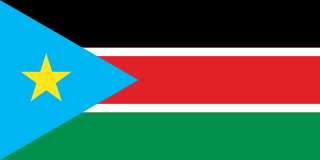
South Sudan, officially the Republic of South Sudan, is a landlocked country in Eastern Africa. It is bordered by Ethiopia, Sudan, the Central African Republic, the Democratic Republic of the Congo, Uganda, and Kenya. Its population was estimated at 10,913,164 in 2022. Juba is the capital and largest city.

Paul Malong Awan, also known as Paul Malong Awan Anei, King Paul, and General Paul, is a South Sudanese politician and military figure. Until 16 May 2017 he was the Chief of General Staffs (COGS) of the Sudan People’s Liberation Army (SPLA). The Chief of General Staffs was the highest-ranking military officer in the SPLA, and also the principal military adviser to the President of the Republic of South Sudan and the National Security Council.
Ethnic violence in South Sudan has a long history among South Sudan's varied ethnic groups. South Sudan has 64 tribes with the largest being the Dinkas, who constitute about 35% of the population and predominate in government. The second largest are the Nuers. Conflict is often aggravated among nomadic groups over the issue of cattle and grazing land and is part of the wider Sudanese nomadic conflicts.
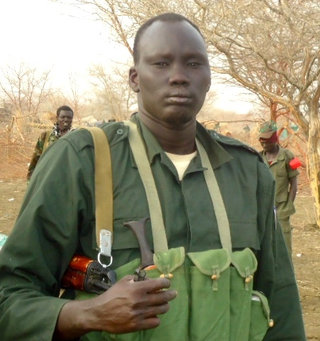
David Yau Yau was a Governor of Boma State and the Chief Administrator of the Greater Pibor Administrative Area of South Sudan. He was previously the leader of a Murle insurrection against the South Sudanese government.

General elections were scheduled to be held in South Sudan by 9 July 2015, the first since independence. However, in light of an alleged coup d'état attempt and continuing conflict in the country this has been thrown into doubt, especially since no permanent constitution has been formulated. The South Sudan parliament voted in April 2015 to amend the country's transitional 2011 constitution to extend the presidential and parliamentary term until 9 July 2018, with 264 members in favour and a handful opposing it. It was postponed again to 2021 in July 2018. Following the peace agreement that ended the civil war, a transitional period of three years was agreed on, which would be followed by elections in 2023. In 2022, the transitional government and opposition agreed to move it to late 2024.

The South Sudanese Civil War was a multi-sided civil war in South Sudan between forces of the government and opposition forces. In December 2013, President Kiir accused his former deputy Riek Machar and 10 others of attempting a coup d'état. Machar denied trying to start a coup and fled to lead the SPLM – in opposition (SPLM-IO). Fighting broke out between the Sudan People's Liberation Movement (SPLM) and SPLM-IO, igniting the civil war. Ugandan troops were deployed to fight alongside the South Sudanese government. The United Nations has peacekeepers in the country as part of the United Nations Mission in South Sudan (UNMISS).

Aweil State was a state in South Sudan that existed between 2 October 2015 and 22 February 2020. It was located in the Bahr el Ghazal region and it borders Gogrial to the east, Lol to the west, Aweil East to the north, and Wau to the south. Its capital and largest city was Aweil.

Aweil East also known as Abiem, was a state in South Sudan that existed between 2 October 2015 and 22 February 2020.It had an estimated population of 571,728 people and an area of 6,172.23 KM square. It was located in northern-western South Sudan. Its capital and largest city was Wanyjok. The state is located in the Bahr el Ghazal region and it bordered Twic State and Gogrial State to the east, Aweil State to the south, Lol State to the west, the disputed Abyei State region to the northeast, and Sudan to the north.
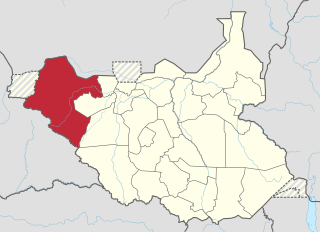
The Lol State was a state of South Sudan with the capital in Raga, that existed between 2 October 2015 and 22 February 2020. It was located in the Bahr el Ghazal region, which is in the northwest section of the country. Lol state bordered Haut-Mbomou and Haute-Kotto in the Central African Republic to the west, South Darfur and East Darfur in Sudan to the north, the disputed region of Kafia Kingi to the northwest, Aweil East State to the northeast, Aweil State to the east, Gbudwe State to the south, and Wau State to the southeast. The state was created alongside 27 other states after a decree issuing the creation of 28 states took place. It was dissolved at the conclusion of the South Sudanese Civil War.
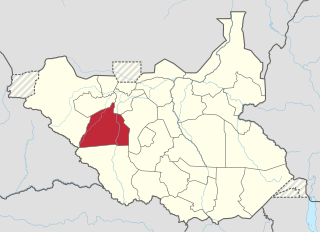
Wau State was a state in South Sudan that existed between 2 October 2015 and 22 February 2020. It was located in the Bahr el Ghazal region, and was part of the former state of Western Bahr el Ghazal. Wau State bordered Aweil State, Gbudwe State, Gogrial State, Lol State, and Tonj State.
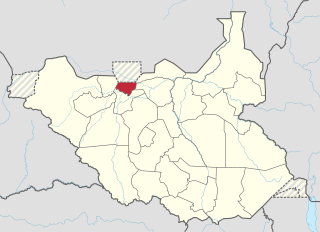
Twic State was a state in South Sudan that existed between 2 October 2015 and 22 February 2020. It was located in the Bahr el Ghazal region and it bordered Aweil East to the west, the disputed Abyei region to the north, Gogrial to the south, Northern Liech to the east, and Ruweng to the northeast. The population of Twic State was recorded at 204,905 in 2008, and was estimated at a population of 543,410 in 2014. The capital of the state was Mayen-Abun, with an estimated population of around 2,000 people in city limits.
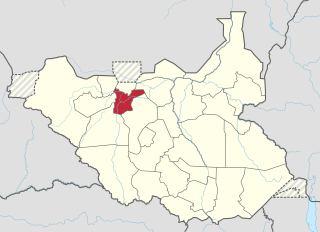
Gogrial State was a state in South Sudan that existed between 2 October 2015 and 22 February 2020. It was located in the Bahr el Ghazal region and it bordered Twic to the north, Aweil East to the northwest, Aweil to the west, Wau to the southwest, Tonj to the southeast, and Northern Liech to the northeast.
Mathiang Anyoor, also spelled Mathiang Anyur, also known as Dot Ke Beny, is a Dinka-affiliated militia group in South Sudan. Originally an ad-hoc volunteer force founded in 2012, the militia was transformed into a private army to protect President Salva Kiir Mayardit and army chief Paul Malong Awan. However, the South Sudanese military (SPLA) claims that it is just another battalion. Much of the ethnic violence against non-Dinkas in the South Sudanese Civil War is attributed to the militia.
This article lists events from the year 2019 in South Sudan
Albino Bol Dhieu is a South Sudanese politician and the incumbent Minister of Youth and Sports in South Sudan since 12 March 2020. He is a member of the Sudan People's Liberation Movement.
References
- 1 2 3 "What UK aid cut means for one South Sudan hospital". BBC News. 2022-07-21. Archived from the original on 2022-11-12. Retrieved 2023-04-23.
- ↑ "Aweil Civil Hospital | EA Health". East African Health Portal. Archived from the original on 2023-04-24. Retrieved 2023-04-23.
- ↑ Ebby Elahi (editor) Insights in Global Health: A Compendium of Healthcare Facilities and Nonprofit Organizations. (2020). United States: CRC Press.
- 1 2 Thomson, Johanna; Schaefer, Myrto; Caminoa, Belen; Kahindi, David; Hurtado, Northan (27 October 2016). "Improved Neonatal Mortality at a District Hospital in Aweil, South Sudan". Journal of Tropical Pediatrics. 63 (3): 189–195. doi:10.1093/tropej/fmw071. PMC 5452431 . PMID 27789662.
- ↑ Issa, Janine. "Dispatch from Aweil, Southern Sudan". The Lamp. 66 (9): 36–37. Archived from the original on 2023-04-24. Retrieved 2023-04-24.
- ↑ "MSF addresses unprecedented malaria outbreak in Aweil". Sudan Tribune. 29 October 2012. ProQuest 1115589965.
- ↑ "S. Sudan's Kiir ignores Abyei issue at Aweil public rally". McClatchy - Tribune Business News. 22 September 2013. ProQuest 1434620174.
- ↑ Hou, Hou Akot (4 September 2012). "South Sudan Officials Warn Spread of Hepatitis B". Voice of America News. ProQuest 1037972713.
- ↑ "What UK aid cut means for one South Sudan hospital". BBC News. 2022-07-21. Archived from the original on 2022-11-12. Retrieved 2023-04-23.